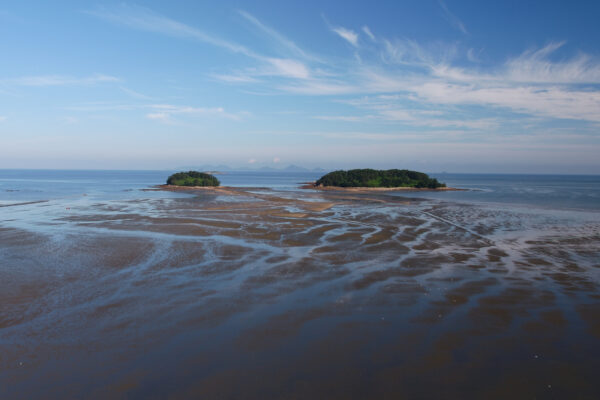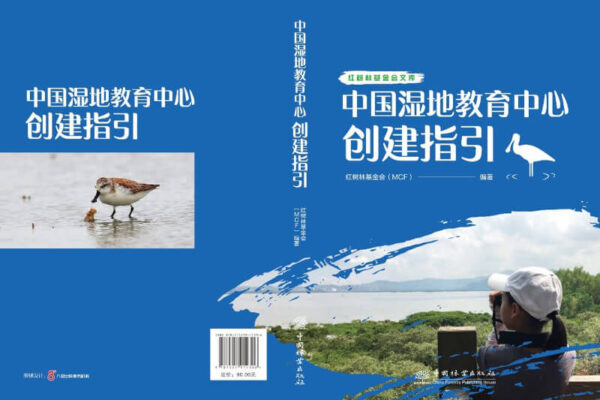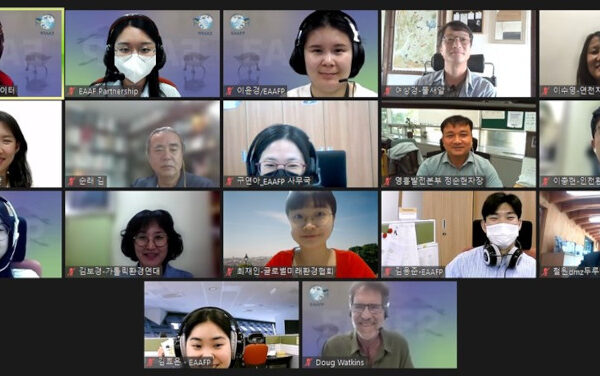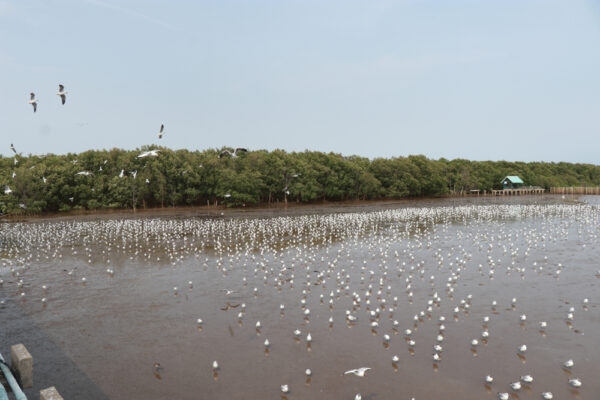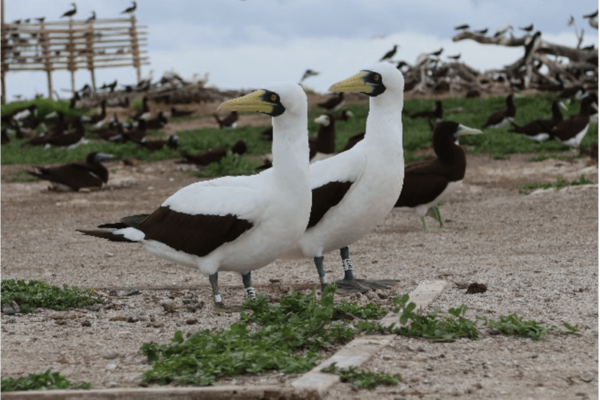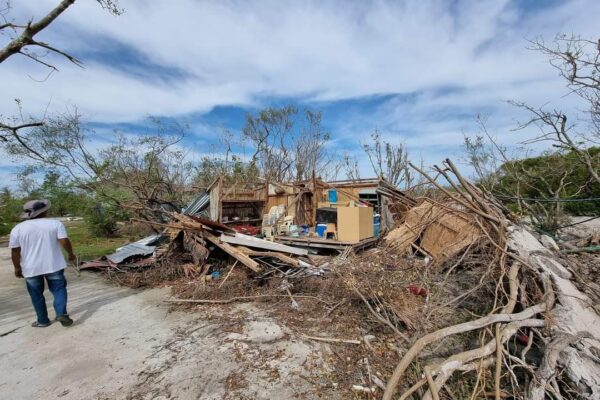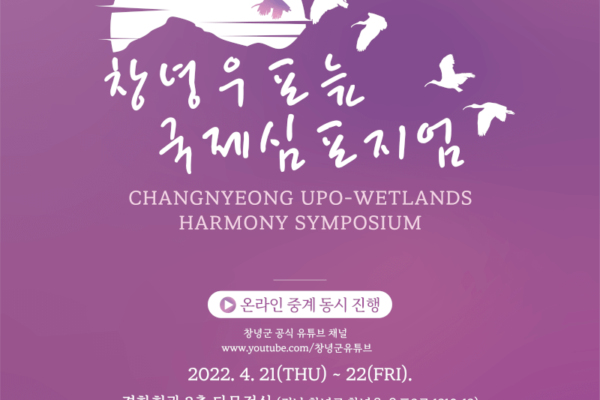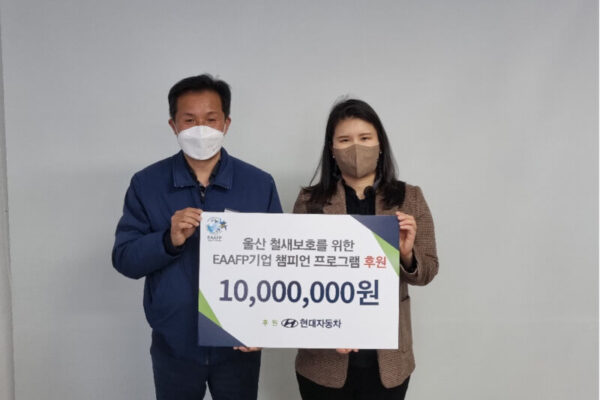-
Welcoming Gochang Getbol from the Republic of Korea as Flyway Network Site, EAAF 153
On 28th August 2022, the East Asian-Australasian Partnership welcomed a new addition to…
Continue reading -
First Upo Wetland Symposium held to promote harmony between birds and people
Upo Wetland © EAAFP Secretariat The 1st Upo Wetland Harmony Symposium was successfully held in Changnyeong County, Ro Korea from 21st to 22nd April 2022. It was hosted by Changnyeong County, with the support from the EAAFP Secretariat with the National Institute of Ecology (NIE), Ramsar Regional Center- East Asia (RRC-EA), and Gyeongsangnamdo Ramsar Environmental Foundation (GREF). Local Project Coordinator of EAAFP Secretariat, Ms. Yeonah Ku and Programme Assistant Hyoeun Kim supported and participated in the event. Upo Wetland Flyway Network Site (EAAF096), also a Ramsar Site, is located in Changnyeong County, Southern part of Ro Korea. The site consists of four natural riverine marshes of Nakdong River. As the site was well-preserved and with suitable habitats, the Ministry of Environment of Korea has reintroduced locally extinct Crested Ibis in the area (link). In addition, Changnyeong County was inscribed as one of the first batches of Wetland Cities by the Ramsar Convention in 2018. For its following action as a Ramsar Wetland City, Changnyeong County held an international symposium, with the Slogan “Upo Wetland, where birds and people belong”. The county is planning to organize a world expo on wetlands in the long run. Q&A session of the symposium © EAAFP Secretariat The symposium consisted of keynote speeches ‘Upo Wetland and Sustainable Development’, and sessions titled ‘Benefits from Wetlands’, ‘Our Promise, Protection on Migratory Waterbirds and Crested Ibis of Upo, Flying Again’, and ‘Discussion’. In the first session, “Benefits of Wetlands”, Dr. Mathew Simpson from ‘35 %’ introduced the Ramsar Convention and its criteria for Ramsar sites considering public awareness; Dr. Wooyeong Joo from NIE evaluated the ecosystem service of the Upo Wetland, based on the Ro Korean policy and the general concept of ecosystem services; and Mr. Seungoh Suh from RRC-EA promoted managing wetlands led by the local NGO. In the second session, Mr. Simba Chan from the Japan Bird Research Association explained the extinction and conservation process of birds, with cases of Yellow-breasted bunting and the Chinese Crested Tern. Which showed the importance of building up strong networks both nationally and internationally. Then, Mr. Nelson Chen from Guandu National Park shared the case of citizen science, as experience in managing the citizen scientists and datasets was valuable for those who need more scientific evidence for conservation. Dr. Seong-Jin Kim shared the conservation status of the Asian Crested Ibis which had been extinct in Ro Korea and successfully reintroduced in Upo Wetland. The second day of the symposium was an excursion to the Upo Wetland, including a visit to the Upo Crested Ibis Restoration Center, and Changnyeong Upo Wetland Eco Center. The Eco Center focuses on ecological elements and provides activities and materials for visitors’ experience, targeting children. The machines for incubating Crested Ibis at the Upo Crested Ibis Restoration Center © EAAFP Secretariat Stepping on the peat layer at the Changnyeong Upo Wetland Eco Center © EAAFP Secretariat Beak description comparing to the tools for humans at the Upo Wetland Eco Center © EAAFP Secretariat Restored Sanbakbeol Wetland Sanbakbeol Wetland used to be agricultural land and now is restored as a marsh of an area of 192,250 m2 in November 2017. There is an artificial island that was designed as a birds’ roosting site. To maintain the environment of the island, . Reed control on the island enhance birds’ usage of the habitat and it proved that more birds visited the roosting site, according to the monitoring cameras that GREF had set on the island. Sanbakbeol Wetland © EAAFP Secretariat Upo, where artists belong Wetlands and wildlife have always been inspiring to artists. Mr. Bongchae Jung, a nature photographer, is one of the artists who has been in love with Upo. He introduces himself as “a photographer ”, meaning that he is now acting as a part of nature, not just as an observer of nature, after decades working for the Upo Wetland. He is a well-known nature photographer, and a lot of his artworks focus on the Upo Wetland, where he lived for more than 20 years. Mr. Jung aims to raise public awareness to conserve wetlands via his artworks. Together with Mr. Jung, there are a number of artists working with ‘Changnyeong Upo Wetland Ecotourism Association’, and they held art events such as Upo Ecological Art Village Project. We can say, nature inspires artists, and their art inspire people to take conservation actions to nature. Mr. Bongchae Jung at the Gallery of Jeong Bongchae © EAAFP Secretariat The photographs of its inside © EAAFP Secretariat Watch the playback: Youtube channel for the symposium
Continue reading -
New Publication “ China Wetland Centers Manual for Planning and Practice” by Mangrove Foundation
By 2021, China has 64 wetlands of International Importance, 20 Flyway Network Sites, 602 Wetland Nature Reserves, 899…
Continue reading -
EAAFP Foundation 2021-2022 Small Grant Winter Project Reporting Workshop
On 26th May, the EAAFP Foundation organized the 2021-2022 Small Grant Winter Project Reporting Workshop online. The 2021-2022 Small Grant Programme was sponsored by the Korea South-East Power Co., Ltd. Yeongheung Power Division (KOEN) with support from Hanns Seidel Foundation (HSF). Following the first workshop last year in 2021, the Foundation have implemented its own Small Grant Programme to support the efforts of the civil society organizations in the Republic of Korea by providing small grant to local projects that aim to conserve migratory waterbirds and their habitats. 8 winter projects were selected and implemented from October 2021 to March 2022. The organizations reported the outcomes of their projects, shared their achievements and discussed improvements. In addition, a short introduction on the 2022-2023 Small Grant Programme was provided for recruitment later this year. The Foundation’s 2022 World Migratory Bird Day donation lucky box event was also presented to the participants. <Learn more about 2021-2022 Small Grant Programme> (in Korean) The 8 grantee NGOs included: 1) Ganghwa Citizen Network, 2) Tidal flat Ecological Education Hub Moolseal, 3) Cheorwon DMZ Crane Eco-tourism group, 4) Wetlands and Birds Korea, 5) Yeoncheon Geological Ecology Network, 6) DMZ Ecology Research Institution, 7) Global Future Environment Association, and 8) KFEM Incheon The representative of the KOEN, HSF, and staff members of the EAAFP Secretariat and the Foundation attended the workshop as well. To kick off the workshop, Mr. Doug Watkins, the Chief Executive of the EAAFP Secretariat and the Chairperson of the EAAFP Foundation gave a congratulatory remark. He expressed gratitude to KOEN and HSF for their financial supports to run the Small Grant Programme, and to 8 participating NGOs for their efforts to conserve the migratory waterbirds and their habitats. He concluded by expressing his wish to continue the cooperation between the EAAFP Foundation and the sponsoring organization and with grantee organizations. Dr. Bernhard Seliger, the Resident representative of Hanns Seidel Foundation Korea, gave his pre-recorded remark. He expressed pleasure for the first step in supporting the small grantees to strengthen communication and help manage the habitats of waterbirds in inner boarder areas of RO Korea. Lastly, the congratulatory speech from Mr. Sun Hyeon Jeong, a senior manager of Environment Technology Department at KOEN Yeongheung Power Division. He said, “We will keep supporting the EAAFP and small grantees to maintain the stabilized relations with EAAFP built over the past 5 years and to protect migratory waterbirds around the border”. Presentation from Ganghwa Citizen Network ©EAAFP Foundation The reporting was proceeded in two separated sessions. During the first session, the Ganghwa Citizen Network gave the first reporting presentation with the project title ‘2021 Crane School-Go on a crane trip’. The organization prepared the project due to a lack of recognition on cranes and emphasized the necessity of recording investigation of cranes and provision of safe environment habitats through the Ganghwa crane monitoring activity. Presentation from Cheorwon DMZ Crane Eco-tourism group ©EAAFP Foundation The second reporting was by Cheorwon DMZ Crane Eco-tourism group, with the project title ‘Feeding and Population Surveys of Cranes’. He analyzed the suitability of Cheorwon Basin (One of EAAFP Flyway Network Sites EAAF 027) as a place for wintering sites and suggested the need for a map with the number of crane populations and their wintering areas. Presentation from KFEM Incheon ©EAAFP Foundation The third reporting followed by KFEM Incheon with the project called ‘A Report on the Monitoring Results of Natural Monuments and Crane Wintering Site’. The project aimed to increase the awareness of conserving the crane’s habitats. With the explanation of the project, the presenter shared the photos at the site with citizen participants and two ecology experts. Presentation from Tidal flat Ecological Education Hub Moolseal ©EAAFP Foundation For the last presentation of the first reporting session, Tidal flat Ecological Education Hub Moolseal shared the outcome of the project, ‘Wintering with Cranes’. They investigated the current habitats of cranes through two monitoring sessions and insisted the importance of preparing resolutions for conserving crane groups in Ganghwa tidal flat. After the break, the participants watched <Bird Meets Arts> summary video produced with the Yeonsu Foundation for Arts and Culture, and the video of Black-faced Spoonbill migrating between Incheon and Hong Kong. Wetlands and Birds Korea ©EAAFP Foundation The second reporting session was proceeded with a presentation from Wetlands and Birds Korea. Through an ‘A Round-table Conference with Local Organizations from Migratory Waterbirds Flyway,’ they announced 2022 Wetland Day Joint Statement between Korea and Japan, and discussed the role for the registration of Korean tidal flats to UNESCO. Presentation from Global Future Environment Association ©EAAFP Foundation Second reporting of the 2nd session was proceeded by Global Future Environment Association, with the project title ‘Research on Ecological Services at Habitats for Migratory Waterbirds in Incheon Economic Free Zone(IFEZ) and Quality of the Habitats’. The project quantified the damage to tidal flats and wetlands located in the Incheon Economic Free Zone, which developed rapidly, to analyze the ecological value as a habitat for migratory waterbirds. Presentation from Yeoncheon Geological Ecology Network ©EAAFP Foundation The last reporting was provided by Yeoncheon Geological Ecology Network about the project, ‘Monitoring Winter Migratory Waterbirds and training for civic scientists in Chatancheon stream, Yeoncheon’. They implemented about 20 sessions of migratory waterbirds monitoring activity and expressed strong ambitions to increase the value of Yeoncheon Imjin-river ecosystem conservation sites through the continuous monitoring and expansion of civil participation activities. After the second reporting session, Ms. Yoon Lee, the External Relations Manager at EAAFP Secretariat introduced the 2022-2023 Small Grant Programme. The detailed information of the programme will be uploaded to EAAFP Foundation website in July, and after the application in August, the result of the selected projects will be notified in September. Lastly, EAAFP Foundation promoted the lucky box event to celebrate the World Migratory Bird Day and encouraged the participants to join the event for the migratory waterbirds and their habitats. The final report for the 2021-2022 Small Grant Programme will be uploaded to the EAAFP Foundation website. Group Photo at 2021-2022 Small Grant Winter Programme Reporting Workshop ©EAAFP Foundation About EAAFP Foundation in Korean (full version) and English summary. <About EAAFP Foundation> The EAAFP Foundation was established in 2019 to contribute to providing the Partnership with a mechanism to support sustainable financing and expand its engagement with various types of organizations for the conservation of migratory waterbirds and habitats in EAA Flyway. The Foundation office is based in Songdo, Incheon, Republic of Korea. For more information, visit EAAFP Foundation.
Continue reading -
Thailand is preparing to propose Bangpu Nature Education Center as Flyway Network Site
Office of Natural Resources and Environmental Policy and…
Continue reading -
Masked Future
The article I wrote, ‘Are the Masked Boobies Home for Good In Tubbataha? A rollercoaster ride on the wings of hope’, was published at the East Asian-Australasian Flyway Partnership website in 2020. It was filled with hope and a smattering of apprehension and despair. Then, I was confident that we would see the resurgence of the masked booby Sula dactylatra population in the Tubbataha Reefs Natural Park Flyway Network Site (EAAF 123) in the Philippines. This singular pair of masked boobies known in the Philippines, has been with us since 2019. The second batch of eggs that it laid resulted in one chick that grew to five months, but which the rangers later found dead for unknown reasons. Marine park rangers regularly monitor the seabirds of Tubbataha, with special attention given to this finicky pair. Rangers built a complicated drainage network to rival that of ancient Rome to ensure the nests remain dry during the rainy season. They would practically walk on tiptoes around these celebrities for fear of causing undue stress. Five times more the pair laid eggs, usually a couple, and these would disappear without a trace, a mystery we have since brought to the attention of seabird experts worldwide through various seabird expert groups. Luckily for us, many were willing to help. Dr. Enriqueta Velarde of the Pacific Seabird group introduced us to Dr. Roxana Torres of the Universidad Nacional Autónoma de México, who specializes in boobies. Like us, Dr. Torres was disconcerted by the breeding failure of our Masked Boobies. At her behest, we tagged the two Masked Booby with metal and plastic ring bands during our seabird census in May 2022 for identification. We are poised to install a camera trap to monitor their breeding behavior and to identify the ‘thief’ of their precious eggs. And so, it is time to wait, to be patient, and to observe in silence. Figure 1. Park ranger, Segundo Conales, and reseracher, Ace Acebuque, installed rings on our lone Masked Booby pair. © B.Jimenez/TMO This couple laid seven pairs of eggs in two years, laying eggs almost every other month during the first quarter of this year alone. It earnestly wants to survive and is working double-time to perpetuate the species. As it is, we can but wait and do what little we can to unmask the future that lies ahead. Meanwhile, the Masked Booby colony we dream of will have to wait. Figure 2. Masked Booby 446 and 256 now sport colored and metal wedding rings. © R.Alarcon/TMO If you have any advice for us, we would be so happy to hear from you! Email Tubbataha at tmo@tubbatahareefs.org or message via Facebook page: @OfficialTubbataha Learn more about this site: https://www.eaaflyway.net/philippines/ Prepared by Angelique Songco, Superintendent, Tubbataha Reefs Natural Park Flyway Network Site
Continue reading -
How you have helped Olango Island in the Philippines recover from super typhoon
©Lorenz Giden Esmero In December 2021, the Philippines was significantly hit by Super Typhoon Rai (Odette). More than 2 million people have been affected, 375 people lost their lives, and almost 700,000 people have been displaced from their homes. It caused damage to basic infrastructures such as housing, buildings, electricity, and water supply. Olango Island, a small coral reef island in the Central Visayas region of the Philippines and Philippines’ first EAAF Network Site (EAAF007) and Ramsar Site, was also devastated by Odette. For its significant number of migratory waterbirds for wintering, staging, and roosting, Olango Island has been considered one of the most important areas in the country. To contribute to the restoration of people’s lives in Olango Island, the EAAFP Secretariat launched a special donation page. The Secretariate mobilized donations from Partners and supporters and delivered 100% of the donations received to the local community in Olango Island in cooperation with Wetlands International in the Philippines. The donations were mainly delivered to the youth and their families associated with the bird sanctuary and Ramsar site. ENR (Environment and Nature Resources) Youth Ambassadors from San Vicente, recognized by DENR (Youth Empowerment Volunteer Exchange -YEVE), is one of the groups we supported. ©Myrson Taneo ©Myrson Taneo Here are the messages from the Olango Island organizer, the ENR Ambassador: “One of the most popular tourist destinations in Olango Island is the Olango Island Wildlife Sanctuary (OIWS), also known as the Bird Sanctuary. Although it is known worldwide, there are residents of Olango Island who do not have a chance to get the opportunity to marvel over the beauty of OIWS. Some residents remain clueless as to how much ecological value as well is at bay. The ENR Ambassador arranged the OIWS Tour on 24 April 2022, entitled ‘The Importance of OIWS in Maintaining Ecological Balance.’ It was attended by volunteers from all over Olango Island, some of which were from the Isla Paraiso Organization and the Parish Youth Catholic Council. Representatives from ENR Ambassador presented the importance of OIWS (Jun Mar Cabarse), Wetlands (Jaynovah Policher), and Seagrasses (Mary Tose Tisoy). Guest speaker, Mr. Arne Jensen from Wetlands International, tackled the Shorebird Migration System of the Migratory Birds, and Mrs. Edilberta Eyas Lambojon, OIWS DMO I of the Department of Environment and Natural Resources, delivered a message about OIWS as well. The presence of birds in a place signifies a healthy environment. On the second half of the tour, ENR Ambassador conducted the ‘Water Bird Gallery Exhibit’ to showcase some of the migratory waterbird species of birds found in the Island, including the flagship species of OIWS, Asian Dowitcher. To ensure that the activity was fruitful, a poster and slogan contest was also held in relation to the tour’s theme. Various ideas and creations were made by our volunteers, deep-rooted from their understanding of the topics discussed beforehand. A clean-up drive was initiated on the OIWS premises as a closing ceremony. The activity was a great success. This would not have been possible without the help of the East Asian-Australasian Flyway Partnership Secretariat through the effort of Mr. Arne Jensen, the Olango Island Wildlife Sanctuary and their staff, our volunteers, and generous donors. We thank you so much for your participation and willingness to learn and grow as an individual that can help our community develop.” © ENR Ambassador team in Olango © ENR Ambassador team in Olango © ENR Ambassador team in Olango © ENR Ambassador team in Olango
Continue reading -
Envisioning Roadmap of the Gochang Tidal Flat World Heritage Site management
To further develop the roadmap for advancing management of Gochang Tidal Flat after its designation as a World Heritage Site in Ro Korea, a 2-day technical workshop for…
Continue reading -
Join the Changnyeong Upo Wetland Harmony Symposium, Ro Korea
With the support of the EAAFP Secretariat, Changnyeong Upo Wetland Harmony Symposium will be held in Changnyeong County, Gyeongsangnam Province, Ro…
Continue reading -
EAAFP Corporate Champion Hyundai Motor Company donated 10,000 USD to EAAFP Foundation
EAAFP Foundation is happy to announce that Hyundai Motor Company, a leading South Korean multinational automotive manufacturer donated 10 million KRW (equivalent to 10,000 USD) to EAAFP Foundation to…
Continue reading

